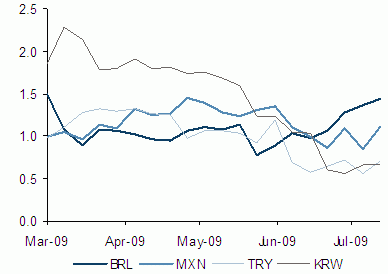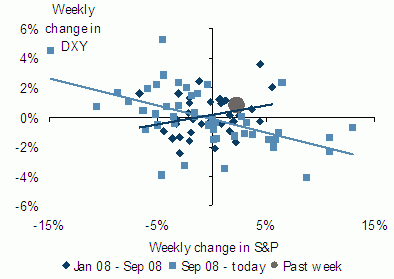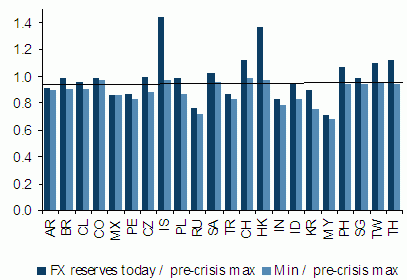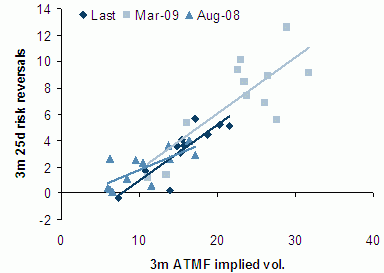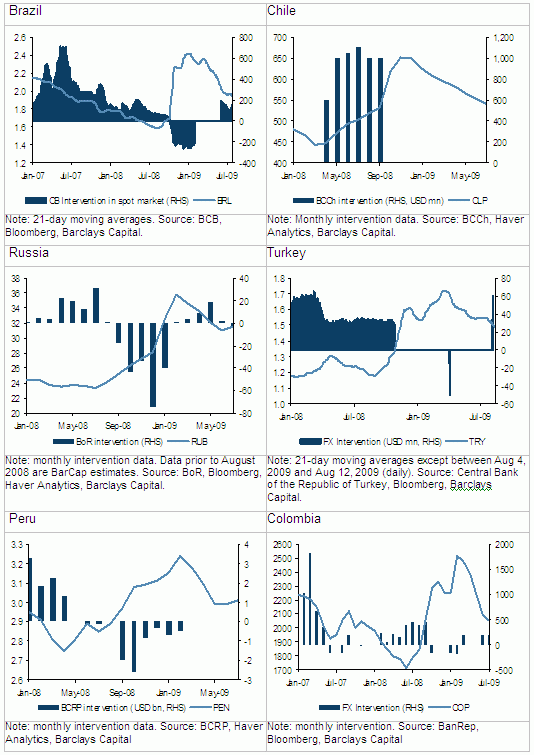In recent years, many developing countries have joined the group of economies that officially run inflation targeting regimes in the context of freely floating exchange rates (Rose 2007). While this has been heralded as the triumph of floating regimes, most emerging economies are still pursuing active exchange rate policies. Prior to the Lehman Brothers bankruptcy meltdown, international reserves in most developing countries (including all four BRICs) had reached historic highs (in terms of both external debt and GDP) and, even among inflation targetters, central banks were active in foreign exchange markets, cushioning the effect of portfolio flows and accumulating reserves. This “fear of floating” in reverse could be labelled, for lack of better alternatives, fear of appreciation (Levy Yeyati and Sturzenegger, 2007).
The crisis by no means has put the policy debate to rest. On the contrary, central bank intervention was critical to limiting exchange rate overshooting during the currency selloff in the last quarter of 2008 and the first quarter of 2009.1 Encouraged by the insurance benefits of liquid reserves during the meltdown, most central banks in emerging economies are already rebuilding reserve stocks and talking down (and selling) the domestic currency to slow down the rise of their currencies. After a one-year crisis-linked hiatus, the post-crisis exchange rate landscape seems to be moving “back to the future”, i.e. a situation that resembles 2007.2
The remarkable synchronicity of the currency rally
Since 9 March 2009, emerging-market currencies have been moving in tandem, a reflection of the strong incidence of common and highly correlated global factors (dollar weakness, equity and commodities strength) that have themselves been driven by a growing conviction that a global recovery is on the way (and the associated increase in the market’s appetite for risk).
A simple two-step exercise illustrates the point.
- First, we can reduce the dimensionality of the global backdrop by computing the principal components of the log weekly changes in equity prices, commodity prices, and the dollar (proxied by the S&P 500 equity index, the CRB commodity index, and the DXY dollar index, respectively), since March 9 to date.3
The fact that the first principal component (PC) explains 70% of the series’ variability – with each individual series highly correlated with the principal component (Table 1) – indicates that the three variables were to a large extent three sides of a single global story.
- Second, we can measure the sensitivity of individual currencies to global factors by estimating the 15-week rolling elasticities of log FX changes with respect to the principal component (their “betas” to the global context, so to speak).
Not surprisingly, those betas were persistently high during the rally (Figure 1), illustrating the dominant role of common global factors.4
Table 1. The remarkable synchronicity of the crisis: Principal component analysis
| |
S&P |
DXY |
CRB |
| Weights |
0.58 |
0.57 |
0.59 |
| Correlation with PC |
0.84 |
0.81 |
0.84 |
Note: The first principal component explains 70% of the series’ variability. Source: Barclays Capital
Figure 1. Synchronicity: 15-week rolling betas to global drivers
Note: Betas are computed with respect to changes in global factors, as captured by the first principal component of the log changes in DXY, S&P and CRB.
Source: Barclays Capital
There are hints, however, of an imminent regime switch that promises to bring the exchange rate debate in emerging economies back to where it ended in 2007. On the one hand, the co-movement of the US dollar with equity and commodity prices – a key aspect behind the synchronicity of the past few months – may be fading as Figure 2 suggests. The safe haven allure of the dollar may be fading and country fundamentals may be moving to centre stage. More to our point, the surprisingly strong intervention by the Bank of Israel in early August suggests that fear of appreciation may be returning as the defining feature of exchange rate policy in emerging markets.
Figure 2. Back to the past: The dollar negative premium may be gone
Source: Bloomberg, Barclays Capital
Fear of appreciation (and the road of less resistance)
Central bank exchange rate intervention, the flipside of reserve accumulation, has been attributed alternatively to precautionary hoarding of liquid dollar assets after the dollar liquidity crises in the 1990s and to the “fear of appreciation” related to a mercantilist attempt to keep the currency undervalued (either to foster the competitiveness of exports or to detract from the competitiveness of imports).5 Ultimately, both are likely to be intertwined, as a depreciated currency, to the extent that it contributes to a current account surplus, both allows the accumulation of foreign assets and preserves some slack on the external front.
Renewed demands for reserves
Lessons from the recent crisis do not suggest that the motives underlying global imbalances are self-correcting. If anything, experience since September 2008 may have revived the prudential motive for reserve accumulation. If the panic late last year taught central bankers anything about reserves, it is that when panic strikes, you just can’t have enough on hand. And, despite the IMF’s valuable attempts to present itself as an international lender of last resort to substitute for precautionary reserve hoarding, the evidence indicates that all large developing countries with the exception of Mexico have chosen to go their own way. More generally, a quick look at the evolution of foreign exchange reserves confirms that the crisis was merely a brief detour from the accumulation path (Figure 3).
Figure 3. Reserves back on track
Source: Haver Analytics, Barclays Capital
At this stage, the relevant question is no longer whether the dollar will continue to weaken but rather by how much and against what. As fundamentals and central bank policy regain their influence on exchange rate behaviour, any remaining dollar adjustment would tend to reflect economic fundamentals as much as the path of less central bank resistance.
Dollar correction, but against what?
The potential for dollar correction against emerging market currencies is not obvious. Eastern European countries continue to sort out their own currency imbalances, and should mirror the economic fate of the Eurozone. Asian currencies are unlikely to lead the way insofar as the Chinese renminbi, against which many Asian currencies are implicitly anchored, remains stable. And Latin America is likely to struggle to reconcile (and possibly redefine) the inflation-targeting paradigm with its intervention pattern. Thus, while a casual look at global capital flows points to currencies in emerging Asia and Latin America as the natural candidates to appreciate vis-à-vis the dollar, the undoing of global imbalances may fall disproportionately on more flexible G10 commodity currencies like the Australian and New Zealand dollars and the euro.
In this sense, regardless of its normative aspects, fear of appreciation has important implications. Against a constructive macroeconomic backdrop, intervention is bound to limit upward moves. By postponing appreciation, this policy will preserve appreciation expectations and thus reduce the tail-risk of unexpected currency depreciation (Figure 4).6 However, this combination of growing appreciation expectations and declining volatility should feedback into the demand for emerging market currencies and the need to intervene to keep them down – a typical central bank conundrum during capital inflow episodes since the mid-1990s. This in turn is likely to lead to an accelerating accumulation of high grade, US dollar-denominated assets by emerging market governments. Ultimately, this feedback loop may condition monetary policy and postpone or derail the pending global rebalancing process.
Figure 4. Devaluation expectations and implied volatilities close to pre-Lehman levels
At any rate, the recent crisis has showed that fear of appreciation is more than a one-off upshot of the bonanza of the early 2000s. It seems to be a part of a more general two-way, leaning-against-the-wind exchange rate policy that promises to be the norm for emerging economy currencies for years to come.
Figure 5. Central bank intervention: Leaning against the wind
References
Aizenman, J. and Lee, J. (2007), “International Reserves: Precautionary Versus Mercantilist Views, Theory and Evidence”, Open Economies Review, Vol. 18, issue 2.
Levy-Yeyati, E. and Sturzenegger, F. (2007), “Fear of Appreciation”, KSG Working Paper 07-047, Harvard University.
Levy-Yeyati, E. and Sturzenegger, F. (2009), “Monetary and Exchange Rate Policies and Economic Development”, forthcoming, Handbook of Development Economics, 5, Chapter 64 (M. Rosenzweig and D. Rodrik, eds.), Elsevier.
Pontines, V. and Rajan, R. (2008), “Asian exchange rate asymmetry,” Vox EU.org, 19 November.
Rose, Andrew (2007). “Are international financial crises a relic of the past? Inflation targeting as a monetary vaccine,” VoxEU.org, 31 May.
1 Indeed, as one of us argues elsewhere (in work in progress with Federico Sturzenegger for Economic Policy), fear of appreciation could be seen as one aspect of more general leaning-against-the-wind exchange rate policy that combines standard monetary policy tools with discretionary reserves purchases and sales to counter the market’s often amplified response to the cyclical pattern of exchange rates.
2 2007 appears a better reference date than mid-2008, when many emerging currencies recorded historic highs at the peak of the commodity bubble.
3 Principal component analysis is a method for choosing the weights of y = a1x1 + a2x2 + … + akxkso that y will capture as much of the variance in the group of variables x1, x2, …, xk as possible.
4 Note that, given the synchronicity of global drivers, the betas to any of these global factors in isolation would exhibit the same pattern – focusing on individual betas would erroneously attribute the rally to equities, commodities, or the dollar, while in fact it was the self-reinforcing combination of the three that was at play.
5 Aizenmann and Lee (2007) make a case for the prudential motive, and Levy Yeyati and Sturzenegger (2009) for a survey of the evolution of de facto exchange rate policies in emerging economies. In a recent Vox EU column, Pontines and Rajan (2008) highlight the incidence of fear of appreciation in Asian currencies.
6 Risk reversal refers to similar (in the sense of having the same delta) out-of-the-money call and put options. A positive risk reversal means the volatility of the call is greater than the volatility of the put, which implies a skewed distribution of expected spot returns, consistent with expectations of a large upward dollar movements (in other words, a currency selloff).
